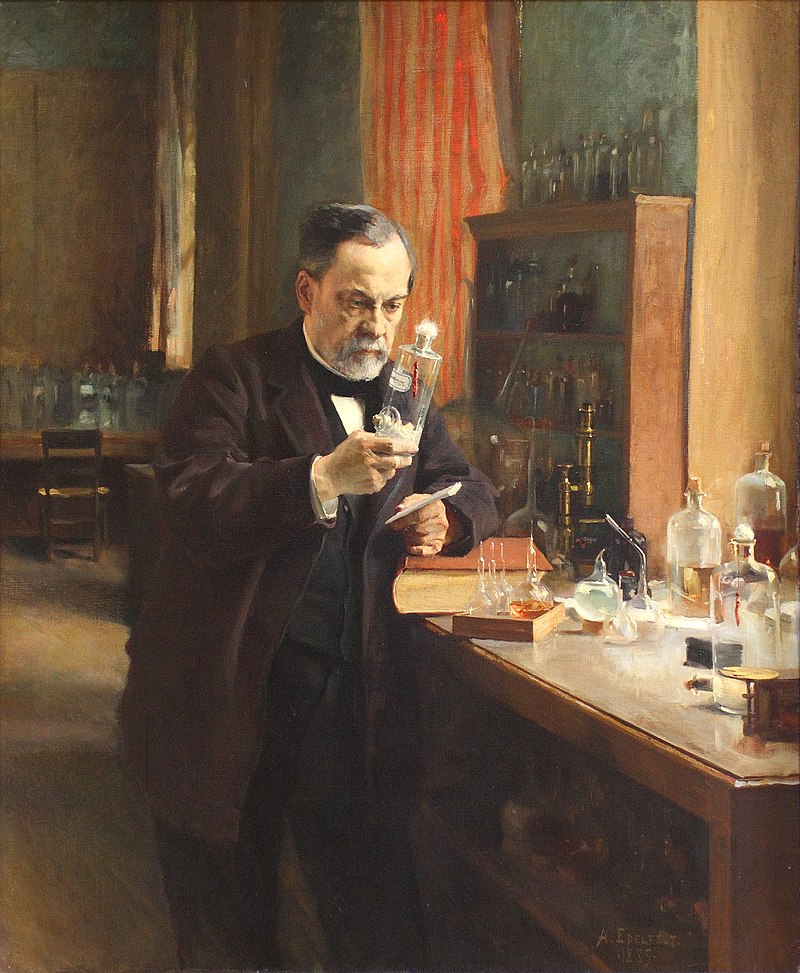
Pasteur in his laboratory (artist: Eldelfeldt) (credit: Wikimedia Commons)
An
indifferent reaction to a new theory’s handling of confusing old evidence is
simply not what happens in real life. When physicists around the world realized
that the Theory of Relativity could be used to explain the shift in the orbit
of Mercury, their confidence that the theory was correct shot up. Their
reaction was anything but indifferent. Most humans are exhilarated when a new
theory they are just beginning to understand gives them solutions to unsolved
old problems.
Hence,
the critics say, Bayesianism is obviously not adequate as a way of
describing human thinking. It can’t account for some of the ways of thinking
that we’re certain we use. We do indeed test new theories against old, puzzling
evidence all the time, and we do feel much more impressed with a new theory if
it can account for that same evidence when all the old theories can’t.
The
response in defense of Bayesianism is complex, but not that complex. What the
critics seem not to grasp is the spirit of Bayesianism. In the deeply
Bayesian way of seeing reality and our relationship to it, everything in the
human mind is morphing and floating. The Bayesian picture of the mind sees us
as testing, reassessing, and restructuring all our mental models all the time.
In the
formula above, the term for my degree of confidence in the evidence, when I
take only my background assumptions as true—namely, the term Pr(E/B)—is never 100 percent. Not even for very familiar old
evidence. Nor is the term for my degree of confidence in the evidence if I do
include the hypothesis in my set of mental assumptions—i.e. the term Pr(E/H&B)—ever
equal to 100 percent. I am never perfectly certain of anything, not of my
background assumptions and not even any of the evidence I have seen repeatedly
with my own eyes.
To
closely consider this situation in which a hypothesis is used to try to explain
old evidence, we need to examine the kinds of things that occur in the mind of
a researcher in both the situation in which the new hypothesis does fit the old
evidence and the one in which it doesn’t.
When the
hypothesis does successfully explain some old evidence, what the researcher is
affirming is that, in the term Pr(E/H&B), the evidence fits the hypothesis,
the hypothesis fits the evidence, and the background assumptions can be
integrated with the hypothesis in a comprehensive way. She is delighted to see
that, if she commits to this hypothesis and the theory underlying it, that will
mean she can feel reassured that the old evidence did happen in the way in which
she and her colleagues observed it. In short, she and her colleagues can feel
reassured that they did their work well.
Sloppy
observation is a haunting fear for all scientists. It's nice to learn that you
didn't mess up.
All these
logical and psychological factors raise her confidence that this new hypothesis
and the theory behind it must be right.
This
insight into the workings of Bayesian confirmation theory becomes even clearer
when we consider what the researcher does when she finds that a hypothesis does
not successfully account for the old evidence. Rarely in scientific research
does a researcher in this situation simply drop the new hypothesis. Instead,
she examines the hypothesis, the old evidence, and her background assumptions
to see whether any or all of them may be adjusted, using new concepts or new
calculations involving newly proposed variables or closer observations of the
old evidence, so that all the elements in the Bayesian equation may be brought
into harmony again.
When the
old evidence is examined in light of the new hypothesis, if the hypothesis does
successfully explain that old evidence, the scientist’s confidence in the
hypothesis and her
confidence in that old evidence both go up. Even if her prior confidence in
that old evidence was really high, she can now feel more confident that she and
her colleagues—even ones in the distant past—did observe that old evidence
correctly and did record their observations accurately.
The value
of this successful application of the new hypothesis to the old evidence may be
small. Perhaps it raises the E value in the term Pr(E/H&B) only a fraction of 1 percent. But that
is still a positive increase in the value of the whole term and therefore a
kind of proof of the explicative value rather than the predictive value of the
hypothesis being considered.
Meanwhile,
the scientist’s degree of confidence in this new hypothesis—namely, the value
of the term Pr(H/E&B)— also goes up another notch as a result of the
increase in her confidence in the evidence. A scientist, like all of us, finds
reassurance in the feeling of mental harmony when more of her perceptions,
memories, and concepts about the world can be brought into cognitive consonance with each other.
No comments:
Post a Comment
What are your thoughts now? Comment and I will reply. I promise.